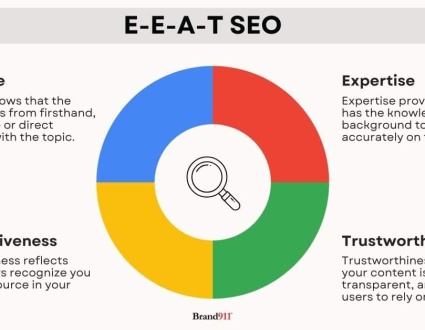Rebranding vs Brand Refresh: Which Does Your Business Need?
- July 18, 2025
- Business Branding

Your brand is not just a logo. It’s how your business competes and grows.
But when your look feels dated or your message no longer fits, it’s time for a change.
The question is: brand refresh vs rebrand?
- A brand refresh updates your visuals and voice without changing who you are.
- A rebrand transforms your identity from the ground up.
Choosing the right path protects your brand reputation, market position, and fuels growth.
This guide breaks down rebrand vs brand refresh so you can decide what your business really needs and why it matters.
Contents:
Why Strategy Comes First
Don’t jump into a brand change just because your logo looks old.
Start with your business goals.
- Are you targeting a new audience?
- Launching a new business model?
- Expanding into new markets?
Your brand should match where you’re headed, not just where you’ve been.
A brand refresh can modernize your look without changing who you are.
A rebrand goes deeper. It reshapes your identity to fit a new strategy.
Think of it like your home:
- Refresh: A renovation—new paint, updated fixtures, same foundation.
- Rebrand: A teardown and rebuild—new structure, new layout, new everything.
Align your branding investment with your strategic direction. That’s how you avoid wasted time, money, and momentum.
What Makes Up a Brand?
A brand isn’t just what people see. It’s what they remember and feel.
Here’s what shapes it:
- Visual identity: Your logo, colors, typography, and design style.
- Textual elements: Your name, brand story, messaging, and voice.
- Sensory elements: The materials you use, your packaging, even your physical spaces.
- Intangible assets: Your reputation, customer trust, and overall brand equity.
All these pieces work together to tell people who you are and why they should choose you.
What is a Brand Refresh?
A brand refresh is a light update that keeps your brand current without changing who you are.
It’s about evolving your look and feel—not starting over. A refresh also supports your broader reputation marketing efforts by keeping your brand visible, relevant, and trusted.
Typical updates might include:
- A new color palette
- Tweaks to your logo
- Updated typography
- A fresh imagery style
- A refined tone of voice
The benefits?
- Lower cost than a full rebrand
- A faster timeline, often 1–2 months
- Keeps your existing brand recognition strong
A good refresh usually stays effective for 3–5 years, helping your brand feel modern and relevant.
What is a Rebrand?
A rebrand is a complete transformation of how your business shows up in the world.
It’s not just a new look, it’s a whole new identity and strategy.
Typical changes can include:
- A new name
- Updated brand values
- Shifts in market positioning
- Targeting new customer segments
The benefits?
- Reinventing your business
- Improving your brand reputation
- Carving out a new place in the market
But there are risks:
- Losing brand recognition and equity
- Confusing loyal customers if the change isn’t clear
A strong rebrand can last 7-10 years if it’s tied to your business goals and done well.
Brand Refresh vs Rebrand: What’s the Difference?
A brand refresh and a rebrand are not the same thing. A refresh evolves your existing brand to keep it current. A rebrand changes your brand from the ground up.
Here’s how they compare:
| Brand Refresh | Rebrand |
| Renovation | New build |
| Retains brand DNA | Changes brand DNA |
| Faster and lower cost | Slower and higher cost |
| Less disruptive | Highly transformative |
| 3-5 year lifespan | 7-10 year lifespan |
Both paths have value, but it’s about choosing the right move for your business goals.
The Role of Brand Audits
Before you decide to refresh or rebrand, you need to know where you stand. That’s where brand audits come in.
Audits reveal gaps between how you see your brand and how others see it.
There are different types to consider:
- Visual: Checks logos, colors, and design for consistency and appeal.
- Verbal: Reviews your messaging, voice, and brand story.
- Behavioral: Looks at how your team represents your brand in actions and service.
- Competitive: Compares your brand to others in your market.
A solid audit gives you facts, not guesses, to guide your next move.
Signs You Need a Brand Refresh
Sometimes your brand doesn’t need a full overhaul, just a modern touch. Here are signs it might be time for a refresh:
- Your visuals look outdated
- Your audience demographics are shifting slightly
- Competitors look fresher and more current
- You’re expanding product lines but keeping the same business model
- You’re aiming for better consistency across all touchpoints
- Your brand still resonates but feels a bit stale
A good refresh can keep you relevant without losing the brand recognition you’ve built.
Signs You Need a Rebrand
A rebrand is a full-on reset for businesses heading in a new direction. You might need one if:
- Your core business direction has changed
- You’re focusing on an entirely new audience
- You’ve faced a reputation crisis and need a clean slate
- Your current brand identity is holding back growth
- Your brand no longer reflects who you are or what you do
A rebrand helps you realign your identity so your brand matches your business today and where you’re headed next.
The Three Types of Rebranding
Not all rebrands are the same. They range from small updates to total transformations.
Here are the three types:
- Partial Rebrand (Refresh): Small changes like new colors, logo tweaks, or updated messaging. It keeps your core brand intact but modernizes how you show up.
- Repositioning: Shifts how your brand is perceived in the market. You might keep your name and visuals but change your messaging, target audience, or brand story to better fit new goals.
- Full Rebrand: A complete overhaul—new name, new visuals, new positioning, and often a new audience. It’s a fresh start when your business has changed fundamentally.
Each level depends on how much your business, and your market, has evolved.
How to Decide: A Strategic Process
Choosing between a refresh and a rebrand isn’t about cost or speed. It’s about alignment. Use this five-step process to make the right call for your business.
Assess Your Current Brand Position
Start by looking at where your brand stands today. Are you well known in your industry? Do customers clearly understand what you offer and what you stand for? If your brand no longer reflects your business or is hard to recognize, it may be time for change.
Identify Pain Points
What’s not working? Are you falling behind competitors with stronger branding? Are you struggling to maintain consistency across platforms? These signals can point to the need for a refresh or a more complete transformation.
Define Your Desired Future State
Think about where you want your brand to be in the next few years. Are you expanding into new markets or targeting new customer segments?
Whether you’re building a national presence or focusing on local SEO for small businesses, a strong brand should support those goals and help you grow into that future.
Evaluate Risks and Rewards
Every brand change comes with trade-offs. Consider the cost, timeline, and possible disruption to customer recognition. Then compare those risks to the potential upsides, like stronger positioning, better growth, or a needed reset.
Make Your Choice
With all the data on the table, decide which path best supports your business goals. In some cases, it makes sense to start small with a refresh, then scale into a full rebrand as needed.
Matching your brand investment to your goals is the smartest move, not just choosing what’s easiest today.
Some businesses start small with a refresh and later move into a full rebrand as they grow. But remember: your investment should match your strategy. Spending less isn’t always saving if it leaves you stuck with a brand that holds you back.
Costs of Refresh vs Rebrand
When it comes to branding, cost depends on the level of change.
Typical costs:
- Brand Refresh: Usually runs about 20–40% of a full rebrand. Focuses on updating visuals and messaging. Faster and more budget-friendly
- Rebrand: A bigger investment in time and money. Involves deep strategy, new positioning, and a full creative rollout
ROI considerations:
- A refresh can last 3–5 years
- A full rebrand can carry you 7–10 years
The real risk? Not investing enough.
When your brand feels off, staying put can lead to:
- Ongoing underperformance
- Missed opportunities in growing markets
- Losing relevance to newer, sharper competitors
Branding isn’t just a cost. It’s how your business shows up and how the world sees you.

Common Mistakes to Avoid
Brand changes can help or hurt, depending on how you approach them. Here’s what to avoid:
- Rebranding just because you’re bored: Internal teams might be tired of the brand, but customers often aren’t. Make sure there’s a real business reason.
- Choosing a refresh when a full rebrand is needed: A light update won’t fix deeper issues like outdated positioning or a broken brand reputation.
- Overinvesting in changes that don’t move the needle: Don’t sink time and budget into things that won’t impact growth or recognition.
- Failing to communicate the “why” behind changes: If customers don’t understand what changed and why, you risk confusion or distrust.
- Skipping the rollout across all channels: Leaving old logos or messaging in tools, templates, and social profiles makes your brand look messy and inconsistent.
A smart strategy avoids these traps while setting your business up for a brand that actually works.
Conclusion
Your brand isn’t static. It should evolve with your business.
Whether you’re scaling up, shifting focus, or staying competitive, your branding must support that growth—and help you stand out online. If you’re not showing up clearly in search, it may be time to rethink how to rank for your name as part of your strategy.
Key takeaways:
- A refresh updates visuals and tone while keeping your brand DNA
- A rebrand transforms your identity and market positioning
- Start with your business goals, not just what “looks” outdated
- Brand audits help clarify what’s working and what’s not
- The cost of doing nothing is often higher than the cost of change
If you’re unsure whether to refresh or rebrand, Brand911 can help you make a clear, strategic decision that protects your business reputation and drives growth.
Schedule a free consultation with our brand strategy team to get started.
FAQs
How long will a refresh vs rebrand last?
A brand refresh typically lasts 3–5 years. A full rebrand can last 7–10 years when done well.
What elements change in each?
A refresh updates visual elements (like colors, fonts, logo tweaks) and messaging tone. A rebrand goes deeper, often including a new name, values, positioning, and target audience.
Can I start with a refresh and evolve into a rebrand?
Yes. Many businesses start small to test updates and gather feedback before committing to a full rebrand.
How do I communicate a refresh to my team and customers?
Keep it simple and clear. Focus on what’s changing, why it matters, and how it supports your future direction. Internal alignment comes first, then share the message externally through your channels.
How do I know if my brand needs updating at all?
Start with a brand audit. Look at how your brand performs visually, verbally, and competitively. If it feels outdated, inconsistent, or misaligned with your goals, it’s time to take action.
About us and this blog
We are a digital marketing company with a focus on helping our customers achieve great results across several key areas.
Request a free quote
We offer professional SEO services that help websites increase their organic search score drastically in order to compete for the highest rankings even when it comes to highly competitive keywords.
Subscribe to our newsletter!
More from our blog
See all postsRecent Posts
- What Is SEO Content? A Comprehensive Guide December 18, 2025
- How to Rebrand Yourself: A Practical 5-Step Plan for Professionals December 16, 2025
- E-E-A-T SEO: What It Is, Why It Matters, and How to Build It December 12, 2025













Recent Comments